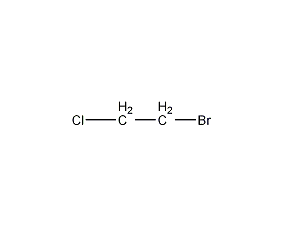
Structural formula
| Business number | 02UH |
|---|---|
| Molecular formula | C2H4BrCl |
| Molecular weight | 142 |
| label |
Chloroethyl bromide, 1-bromo-2-chloroethane, 1-Chloro-2-bromoethane, 2-Chloro-1-bromoethane, Bromoethyl chloride, 1,2-bromochloroethane, 2-Bromoethyl chloride, 2-Chloro-1-bromoethane, 2-Chloroethyl bromide, 1-Bromo-2-chloroethane, 1-Chloro-2-bromoethane, Ethylene chlorobromide, 1,2-Bromochloroethane, fumigant, Halogenated hydrocarbon solvents |
Numbering system
CAS number:107-04-0
MDL number:MFCD00000962
EINECS number:203-456-0
RTECS number:KH6500000
BRN number:605265
PubChem number:24850159
Physical property data
1. Properties: Colorless liquid with an odor similar to chloroform.
2. Boiling point (ºC, 101.3kPa): 107
3. Boiling point (ºC, 98kPa): 104~105
4. Melting point (ºC) : -16.7
5. Relative density (g/mL, 20/4ºC): 1.7392
6. Refractive index (n20ºC): 1.4920
7. Flash point (ºC): None
8. Fire point (ºC): None
9. Vapor pressure (kPa, 86.0ºC): 53.33
10. Vapor pressure (kPa, 38ºC): 8.00
11. Heat of evaporation (KJ/mol, 82.7ºC): 33.1
12. Heat of fusion (KJ/mol): 9630
13. Specific heat capacity (KJ/(kg·K), 25ºC, constant pressure): 0.91
14. Solubility (%, water, 30~80ºC): 0.7
15. Solubility: Hardly soluble in water, miscible with organic solvents such as ethanol, ether, carbon tetrachloride, and heptane. Can dissolve cellulose ester and cellulose ether.
Toxicological data
1. Acute toxicity: Rat oral LD50: 64mg/kg;
2. Mutagenicity Microbial Salmonella typhimurium mutation: 1mmol/L; DNA repair of Escherichia coli: 10mg/plate; Drosophila melanogaster Specific trajectory test of the mouth: 1mmol/L;Trajectory test: 7ppm; Drosophila oral sex chromosome damage and non-disjunction: 1mmol/L; Mouse intraperitoneal DNA damage: 500μmol/kg; Non-mammalian multiplex micronucleus test: 1250μg/L ; Hamster ovary gene mutation: 4mmol/L; 3. The toxicity is the same as 1,2-dichloroethane, which is harmful to the liver and kidneys. Poisoning can occur through skin contact, oral administration and inhalation of vapor.
Ecological data
This substance is harmful to the environment, and special attention should be paid to the pollution of water bodies.
Molecular structure data
1. Molar refractive index: 23.89
2. Molar volume (cm3/mol): 86.1
3. Isotonic specific volume (90.2K ): 202.3
4. Surface tension (dyne/cm): 30.4
5. Dielectric constant:
6. Dipole moment (10-24cm3):
7. Polarizability: 9.47
Compute chemical data
1. Reference value for hydrophobic parameter calculation (XlogP): 1.6
2. Number of hydrogen bond donors: 0
3. Number of hydrogen bond acceptors: 0
4. Number of rotatable chemical bonds: 1
5. Number of tautomers: none
6. Topological molecule polar surface area 0
7. Number of heavy atoms: 4
8. Surface charge: 0
9. Complexity: 10
10. Number of isotope atoms: 0
11. Determine the number of atomic stereocenters: 0
12. Uncertain number of atomic stereocenters: 0
13. Determine the number of chemical bond stereocenters: 0
14. Number of uncertain chemical bond stereocenters: 0
15. Number of covalent bond units: 1
Properties and stability
Avoid contact with strong oxidants, strong bases, and magnesium. It releases toxic gases containing chlorine and bromine when it is decomposed by heat. React with alkali to remove hydrogen halide.
Storage method
Stored in a cool, ventilated warehouse. Keep away from fire and heat sources. Protect from direct sunlight. Keep container tightly sealed. They should be stored separately from oxidants, alkalis, and magnesium food chemicals, and avoid mixed storage. Equipped with the appropriate variety and quantity of fire equipment. The storage area should be equipped with emergency release equipment and suitable containment materials.
Synthesis method
Derived from the reaction of chlorohydrin and phosphorus tribromide. First add chloroethanol to the reaction bottle, cool it with water, gradually add phosphorus tribromide dropwise while stirring, control the temperature to 20-30°C, stir at room temperature for half an hour, heat to reflux for 1 hour, cool, and use 5% sodium hydroxide Wash, separate the water layer, wash until neutral, wash with water, and then dehydrate with anhydrous sodium carbonate. Fractionate the obtained crude product and collect the 106-108°C fraction as the finished product.
Purpose
Used as pesticide and pharmaceutical intermediates. Used as organic synthesis intermediates, solvents, and fumigants.


